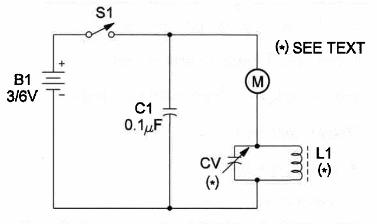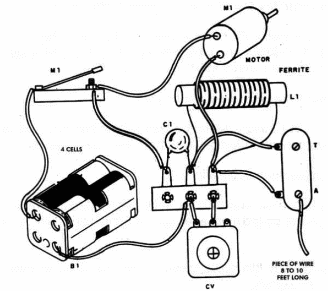The purpose of this simple experiment is to produce noise in the AM radio band.
The circuit can be used to show how brush motors and general appliances with motors can generate noise in the radio band, interfering in radio, TV, and radio communication services.
The circuit is very simple and the produced noise is too weak to cause any problem to radio receivers. (FCC rules about noise and radio interference are severe.
The noise produced by this experiment will interfere only in receivers just a few feet away.
The schematic diagram of the device is shown in Figure 1.

The heart of the circuit is a small DC motor that works as a automatic key, producing rapid variation in the current flow.
A mechanical view of the circuit, using a terminal strip as chassis, is shown in Figure 2.

All the components, including the power supply, can be fixed on a plastic board.
Any small DC motor obtained from a nonworking toy can be used in this project.
The power supply depends upon the motor used.
CV and L1 can be obtained from any nonworking AM radio.
You can get more power for the RF noise by wiring a piece of wire to the antenna (A) terminal, but limit this wire to no longer than 6 feet.
L1 is formed by 100 turns of No.28 wire wound on a ferrite rod (diameter and length are not critical).
By adjusting CV, you can try to tune the signal to be stronger on a dead point of the AM radio band.
Noise Generator
B1 - 3 to 6V - cells or battery - see text
T - Key or SPST toggle or slide switch
C1 - 0.1 µF ceramic or metal plate capacitor
CV - 365 pF variable capacitor
L1 - loopstick - see text
M - 3 to 6V DC motor
Ideas to Explore
To learn more about the circuit or to get more performance:
Try to produce RF noise in the high-frequency band by replacing L1. With a 30-turn coil on a ferrite rod you can produce signals in the range between 2 and 7 MHz.
Explain how RF noise is produced.
Find out through reference books how Marconi and other radio pioneers generated radio waves from their transmitters.
Science and uncommon applications:
You can show how antique radio transmitters operated using this circuit. Morse coded messages can be transmitted using a key in place of S1.
Explain why this noise generator can be used to transmit voice-modulated signals.




